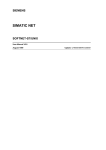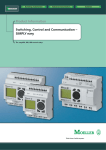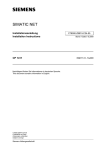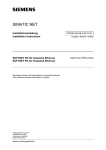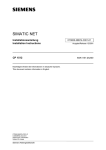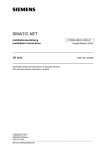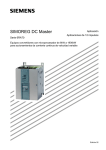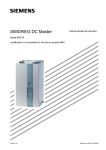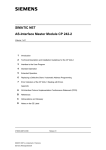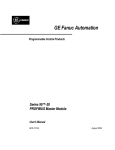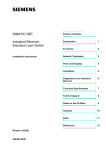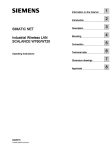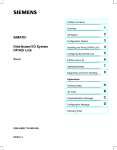Download Siemens SIMATIC NET Technical data
Transcript
SIMATIC NET Introduction to PROFIBUS on Industrial PC Volume 1 of 1 1 The Product Spectrum Around the CP 5412 (A2) 2 How to Use the Manuals 3 Description of the Architecture 4 Addresses for Help and Training 5 Further Reading Glossary C79000-G8976-C068 SIMATIC NET is a trademark of Siemens Siemens Aktiengesellschaft Release 05 Wir haben den Inhalt der Druckschrift auf Übereinstimmung mit der beschriebenen Hard- und Software geprüft. Dennoch können Abweichungen nicht ausgeschlossen werden, so daß wir für die vollständige Übereinstimmung keine Gewähr übernehmen. Die Angaben in der Druckschrift werden jedoch regelmäßig überprüft. Notwendige Korrekturen sind in den nachfolgenden Auflagen enthalten. Für Verbesserungsvorschläge sind wir dankbar. Technische Änderungen vorbehalten. Weitergabe sowie Vervielfältigung dieser Unterlage, Verwertung und Mitteilung ihres Inhalts nicht gestattet, soweit nicht ausdrücklich zugestanden. Zuwiderhandlungen verpflichten zu Schadenersatz. Alle Rechte vorbehalten, insbesondere für den Fall der Patenterteilung oder GM-Eintragung. C79000-G8976-C068 Copyright © Siemens AG 1996 All Rights Reserved We have checked the contents of this manual for agreement with the hardware described. Since deviations cannot be precluded entirely, we cannot guarantee full agreement. However, the data in this manual are reviewed regularly and any necessary corrections included in subsequent editions. Suggestions for improvement are welcome. Technical data subject to change. Nous avons vérifié la conformité du contenu du présent manuel avec le matériel et le logiciel qui y sont décrits. Or, des divergences n'étant pas exclues, nous ne pouvons pas nous porter garants pour la conformité intégrale. Si l'usage du manuel devait révéler des erreurs, nous en tiendrons compte et apporterons les corrections nécessaires dès la prochaine édition. Veuillez nous faire part de vos suggestions. Nous nous réservons le droit de modifier les caractéristiques techniques. Siemens Aktiengesellschaft The reproduction, transmission or use of this document or its contents is not permitted without express written authority. Offenders will be liable for damages. All rights, including rights created by patent grant or registration of a utility or design, are reserved. C79000-G8976-C068 Copyright © Siemens AG 1996 All Rights Reserved Toute communication ou reproduction de ce support d'informations, toute exploitation ou communication de son contenu sont interdites, sauf autorisation expresse. Tout manquement à cette règle est illicite et expose son auteur au versement de dommages et intérêts. Tous nos droits sont réservés, notamment pour le cas de la délivrance d'un brevet ou celui de l'enregistrement d'un modèle d'utilité. C79000-G8976-C068 Copyright © Siemens AG 1996 All Rights Reserved Elektronikwerk Karlsruhe Printed in the Federal Republic of Germany SIMATIC NET Introduction to PROFIBUS on Industrial PC Description C79000-B8976-C068/05 Note We would point out that the contents of this product documentation shall not become a part of or modify any prior or existing agreement, commitment or legal relationship. The Purchase Agreement contains the complete and exclusive obligations of Siemens. Any statements contained in this documentation do not create new warranties or restrict the existing warranty. We would further point out that, for reasons of clarity, these operating instructions cannot deal with every possible problem arising from the use of this device. Should you require further information or if any special problems arise which are not sufficiently dealt with in the operating instructions, please contact your local Siemens representative. General This device is electrically operated. In operation, certain parts of this device carry a dangerously high voltage. WARNING ! ! Failure to heed warnings may result in serious physical injury and/or material damage. Only appropriately qualified personnel may operate this equipment or work in its vicinity. Personnel must be thoroughly familiar with all warnings and maintenance measures in accordance with these operating instructions. Correct and safe operation of this equipment requires proper transport, storage and assembly as well as careful operator control and maintenance. Personnel qualification requirements Qualified personnel as referred to in the operating instructions or in the warning notes are defined as persons who are familiar with the installation, assembly, startup and operation of this product and who posses the relevant qualifications for their work, e.g.: − Training in or authorization for connecting up, grounding or labelling circuits and devices or systems in accordance with current standards in safety technology; − Training in or authorization for the maintenance and use of suitable safety equipment in accordance with current standards in safety technology; − First Aid qualification. Manuals for PROFIBUS on Industrial PC Introduction to PROFIBUS on Industrial PC .............................................. C79000-G8976-C068 ET 200 Distributed I/O System.........................................................................6ES5 998-3ES22 Configuring the S7 Mode with COML S7 ................................................... C79000-G8976-C074 DP Programming Interface........................................................................ C79000-G8976-C071 FDL Programming Interface...................................................................... C79000-G8976-C072 FMS Programming Interface ..................................................................... C79000-G8976-C073 S7 Programming Interface ........................................................................ C79000-G8976-C077 Introduction to PROFIBUS on Industrial PC C79000-G8976-C068 5 Contents 1 The Product Spectrum Around the PROFIBUS on Industrial PC .....................................7 2 How to Use the Manuals .................................................................................................9 3 3.1 3.2 3.3 3.4 3.5 3.5.1 3.5.2 3.5.3 3.5.4 3.5.5 3.6 3.7 3.8 Description of the Architecture ......................................................................................11 The ISO/OSI Reference Model .....................................................................................12 SIMATIC NET Communications Networks ....................................................................13 PROFIBUS ...................................................................................................................14 Network Architecture.....................................................................................................15 Overview of the Protocols.............................................................................................16 The PG Protocol ...........................................................................................................16 FMS Programming Interface.........................................................................................17 The DP Protocol ...........................................................................................................18 S7 Programming Interface............................................................................................20 The FDL Protocol .........................................................................................................21 The Multiprotocol Mode ................................................................................................22 Software and Hardware Components............................................................................23 Communications Options..............................................................................................25 4 4.1 4.2 Where to Obtain Help ...................................................................................................27 Help with Technical Questions ......................................................................................27 Contacts for SIMATIC NET Training .............................................................................28 5 Further Reading............................................................................................................29 Glossary..................................................................................................................................31 6 Introduction to PROFIBUS on Industrial PC C79000-G8976-C068 The Product Spectrum Around the PROFIBUS on Industrial PC 1 The Product Spectrum Around the PROFIBUS on Industrial PC PROFIBUS CP SIMATIC NET communications processors like the CP 5412 (A2) or CP 5511 form the hardware basis for attaching your personal computer (PC) or programming device (PG) to PROFIBUS. Product Combinations The following software products can only be used, if a PROFIBUS communications processor is installed in your PC or PG. Not every software package is available for all operating systems and all PROFIBUS communications processors. Further information about the possible combinations can be found in the SIMATIC NET catalog "IK 10" and the product information. PG Package With this software, you can operate the STEP 5 and STEP 7 program packages via PROFIBUS. DP Package With this software, you can develop and use application programs for the DP master on your PC or PG. DP package contains the FDL programming interface, with which you can develop and use application programs for communication using layer 2 of PROFIBUS (for example, for communication with the SIMATIC S5-95). FMS Package With this software, you can develop and use application programs for FMS (layer 7 of PROFIBUS) on your PC or PG. S7 Package With this software, you can develop and use application programs for the S7 protocol (for data exchange with SIMATIC S7 systems) on your PC or PG.❏ Introduction to PROFIBUS on Industrial PC C79000-G8976-C068 7 The Product Spectrum Around the PROFIBUS on Industrial PC NOTES 8 Introduction to PROFIBUS on Industrial PC C79000-G8976-C068 Description of the Architecture 2 How to Use the Manuals Users of STEP 5 and STEP 7 Read • the chapter Description of the Architecture, • the Hardware Installation Instructions for your CP and • the Software Installation Instructions for the PG package. Users of DP Applications Read • the chapter Description of the Architecture, • the Hardware Installation Instructions for your CP, • the Software Installation Instructions for the DP package and • the volume "ET 200 Distributed I/O System". Programmers of DP Applications Read • the chapter Description of the Architecture, • the Hardware Installation Instructions for your CP, • the Software Installation Instructions for the DP package, • the volume "The DP Programming Interface" and • the volume "ET 200 Distributed I/O System". Users of FDL Applications Read • the chapter Description of the Architecture, • the Hardware Installation Instructions for your CP and • the Software Installation Instructions for the DP package. Programmers of FDL Applications Read • the chapter Description of the Architecture, • the Hardware Installation Instructions for your CP, • the Software Installation Instructions for the DP package and • the volume "FDL programming interface". Introduction to PROFIBUS on Industrial PC C79000-G8976-C068 9 Description of the Architecture Users of FMS Applications Read • the chapter Description of the Architecture, • the Hardware Installation Instructions for your CP, • the Software Installation Instructions for the FMS package and • the configuration instructions in the volume "ET 200 Distributed I/O System". Programmers of FMS Applications Read • the chapter Description of the Architecture, • the Hardware Installation Instructions for your CP, • the Software Installation Instructions for the FMS package, • the configuration instructions the volume "ET 200 Distributed I/O System" and • the volume "FMS Programming interface“. Users of S7 Applications Read • the chapter Description of the Architecture, • the Hardware Installation Instructions for your CP, • the Software Installation Instructions for the S7 package and • the configuration instructions in the volume "Configuring the S7 Mode with COML S7". Programmers of S7 Applications Read • the chapter Description of the Architecture, • the Hardware Installation Instructions for your CP, • the Software Installation Instructions for the S7 package and • the configuration instructions in "Configuring the S7 Mode with COML S7" and • the volume "S7 Programming Interface". ❏ 10 Introduction to PROFIBUS on Industrial PC C79000-G8976-C068 Description of the Architecture 3 Description of the Architecture This chapter provides you with an overview of the following: • The conditions for trouble-free operation of a communications system. • General information about the communications systems available from Siemens. • Detailed information about the PROFIBUS communications network. At the end of the chapter • You will have the basic information you require about the reference model for communication, the ISO/OSI model. • You will have an overview of the various communications networks available from Siemens for different applications and requirements. • You will know the PROFIBUS architecture. Above all, you will recognize the advantages of using PROFIBUS, such as: • Communication between all devices. • Independence from specific vendors in a heterogeneous network. • Applications based on standards allowing long-term planning and use of equipment and systems. Introduction to PROFIBUS on Industrial PC C79000-G8976-C068 11 Description of the Architecture 3.1 The ISO/OSI Reference Model Trouble-Free Interaction As the user of powerful automation components such as host computers, programmable logic controllers, printers, data servers etc., you expect trouble-free interaction between these devices and control systems and features such as: • Use of communication systems without time-consuming configuration and programming. • Independence from any one particular vendor. • Flexible modification of plant structures without affecting communication. • The highest possible reliability in data transmission. • Long-term planning and use of equipment (today’s devices should be able to communicate with those of tomorrow). Open Communication The answer to such requirements is a heterogeneous network of automation components, in which devices from a variety of vendors can communicate (open communication). In contrast, in a homogeneous network, only devices of one vendor can communicate with each other. The ISO/OSI Reference Model The International Standards Organization (ISO) defined a reference model for open system communication for heterogeneous networks. This ISO/OSI reference model provides a guideline for standardization of communications procedures. It provides a framework for standardizing communications procedures in seven layers. All manufacturers of automation components or generally of data terminal equipment, not only for industry, today base their products on the ISO/OSI reference model (Figure 3.1). The Seven Layers of the ISO/OSI Model 7 The Layers Application layer and Their Tasks Provides uniform access to specific services. Establishes transfer syntax. 6 Presentation layer 5 Session layer Establishes, maintains, terminates communication sessions 4 Transport layer 3 Network layer Transfers “raw” information reliably. Provides network connections. 2 Data link layer 1 Physical layer Establishes and terminates links. Regulates physical connections for bit transfer. Figure 3.1 The Seven Layers of the ISO/OSI Reference Model 12 Introduction to PROFIBUS on Industrial PC C79000-G8976-C068 Description of the Architecture 3.2 SIMATIC NET Communications Networks The Areas of Application of SIMATIC NET SIMATIC NET is an open, heterogeneous communications system with a variety of local area networks (LANs) providing various ranges of performance for manufacturing and process automation in industry. It is based on national and international standards according to the ISO/OSI reference model. SIMATIC NET Communications Networks SIMATIC NET provides the following communications networks for different requirements (Figure 3.2): • Industrial Ethernet, a cell and management level network based on IEEE 802.3 (ETHERNET). • PROFIBUS, a cell and field level communications network complying with PROFIBUS (Process Field Bus, En 50 170. /1/ • AS-Interface (based on AS-i) a communications network for the actuator and sensor level. Management level Cell level Industrial Ethernet Field level PROFIBUS Actuatorsensor level AS-Interface Figure 3.2 SIMATIC NET Communications Networks Introduction to PROFIBUS on Industrial PC C79000-G8976-C068 13 Description of the Architecture 3.3 PROFIBUS Area of Application of PROFIBUS PROFIBUS is • the network for the cell and field area of the medium performance range within the open, heterogeneous SIMATIC NET communications system intended primarily for an industrial environment. • a powerful communications system for low-cost applications. It provides all the known advantages of a bus system and meets all the requirements for flexible, cost-effective networking of programmable logic controllers and computers in an industrial environment. PROFIBUS Known under the name PROFIBUS, PROFIBUS is based on the standard specified in EN 50 170 and is based on the ISO/OSI reference model. By meeting the requirements of EN 50 170, PROFIBUS provides the “openness” required for attaching components from other vendors that comply with the standard. The Protocol Profile of PROFIBUS PROFIBUS (Figure 3.3) is based on the ISO/OSI reference model, but does not implement all seven layers. For reasons of performance and to reduce costs, only layers 1 (Physical Layer / RS485) and 2 (Data Link Layer / FDL) for the physical bus characteristics and access techniques and layer 7 (Application Layer) as the user interface are implemented. The attachment of layer 7 to layer 2 is controlled by the lower layer interface (LLI). This provides all the required layer 3 to 6 functions. Architecture of PROFIBUS 7b 7a FMS DP S7 LLI (Lower Layer Interface) 6 5 empty empty 4 Transport 3 Network 2 FDL (Fieldbus Data Link) 1 RS 485 homogeneous expansions user interfaces Figure 3.3 The PROFIBUS Architecture 14 Introduction to PROFIBUS on Industrial PC C79000-G8976-C068 Description of the Architecture 3.4 Network Architecture PC and PROFIBUS PC/ workstation with PROFIBUS CP PC/PG with PROFIBUS CP SIMATIC S5 PC/PG with SCOPE for PROFIBUS and PROFIBUS CP SIMATIC S7 PROFIBUS DP slave DP slave FMS slave Figure 3.4 Network Architecture of PROFIBUS Introduction to PROFIBUS on Industrial PC C79000-G8976-C068 15 Description of the Architecture 3.5 Overview of the Protocols 3.5.1 The PG Protocol Area of Application of the PG Protocol The PG protocol is used to operate the STEP 5 or STEP 7 SIMATIC software packages with SIMATIC NET communications processor. This protocol allows access by STEP 5 or STEP 7 programs to SIMATIC programmable logic controllers via PROFIBUS. The PG protocol is not yet available for the UNIX operating system. 16 Introduction to PROFIBUS on Industrial PC C79000-G8976-C068 Description of the Architecture 3.5.2 FMS Programming Interface SAPI-FMS The Siemens implementation of the FMS programming interface is known as SAPI-FMS. What Does SAPIFMS Mean? The acronym SAPI-FMS stands for: • SAPI - Simple Application Programmers Interface • FMS - Fieldbus Message Specification - the layer 7 communications protocol of PROFIBUS. What Is SAPI-FMS? SAPI-FMS • represents a simple C programming interface, • provides access to the FMS services on PCs and PGs and • is available as a C library and is operated with SIMATIC NET drivers and SIMATIC NET communications processors. Advantages of the SAPI-FMS Programming Interface The SAPI-FMS programming interface has the following advantages: • SAPI-FMS is a simple but flexible and powerful interface. • The SAPI-FMS programming interface uses asynchronous procedures. • SAPI-FMS handles sequential services such as the transfer of a communication relationship list automatically. • SAPI-FMS converts variable data automatically into the format of the local CPU. • SAPI-FMS supports troubleshooting with an integrated trace function. • The SAPI-FMS programming interface is compatible with other SAPI programming interfaces. • The SAPI-FMS programming interface can also be used by other programs, for example BASIC or Pascal programs. Introduction to PROFIBUS on Industrial PC C79000-G8976-C068 17 Description of the Architecture 3.5.3 The DP Protocol Distributed I/Os The distributed peripheral I/Os (abbreviated to DP) allow you to use a large number of distributed analog and digital input/output modules in the immediate vicinity of the process. Networking DP components using PROFIBUS means a considerable reduction in cabling compared with previous direct wiring of the components. Large distances between the individual I/O devices can be bridged by PROFIBUS (PROFIBUS). Distributed I/O stations collect the input signals locally and these are then fetched by the central controller in the computer. The central controller also sends output data to the distributed I/O stations cyclically. The DP protocol is intended for time-critical applications. An optimized and simplified transmission protocol means high transmission rates and the use of a master-slave structure results in short cycle times. The DP protocol is based on the communications standard for the field area (PROFIBUS EN 50 170) EN 50 170. The concept of DP communication was worked out in a common project undertaken by leading manufacturers of automation equipment. It describes a heterogeneous transmission protocol tailor-made for the requirements of the field area. Main Characteristics The main characteristics of the distributed peripheral I/O system are as follows: • Central control by one master. • High data throughput thanks to a simple transmission protocol. • Cyclic transmission of the process image in the input and output direction. • Simple, cost-effective network attachment. • Data transmission with the option of twisted-pair (RS 485) or fiberoptic cables. • Detection of errors with on-line diagnostics. • Based on EN 50 170, allowing parallel operation with FMS devices (masters and slaves) on one bus. 18 Introduction to PROFIBUS on Industrial PC C79000-G8976-C068 Description of the Architecture The DP Interface of a PROFIBUS CP Figure 3.5 shows the basic structure and the components of a PROFIBUS-DP system controlled by a computer with a PROFIBUS communications processor installed. DP master with PROFIBUS CP DP master/slave communication Master/master communication PROFIBUS DP slaves Process Other stations Figure 3.5 Basic Structure Definition of DP Slave and DP Master The PROFIBUS standard EN 50 170 defines two classes of station on the bus: • Passive stations • Active stations In the distributed I/O system, the I/O devices are passive stations. They are known as DP-Slaves. The DP slaves are controlled by an active master station. This master station is known as the DP master. DP Programming Interface The DP programming interface allows the use of a PROFIBUS CP in a PG/PC as a DP master class 1. The PC in conjunction with the PROFIBUS CP controls communication with the distributed I/O devices and handles the central functions of a DP master class 1 according to EN 50 170. This involves the following functions: • Initialization of the DP system. • Parameter assignment/configuration of the DP slaves. • Cyclic data transfer to the DP slaves. • Monitoring the DP slaves. • Preparing diagnostic information. Introduction to PROFIBUS on Industrial PC C79000-G8976-C068 19 Description of the Architecture 3.5.4 S7 Programming Interface SAPI-S7 SAPI-S7 is the C programming interface for access to the S7 communications protocol on PGs/PCs. What Does SAPI-S7 Mean? The acronym SAPI-FMS stands for: • SAPI - Simple Application Programmers Interface • S7 layer 7 communications protocol for SIMATIC S7 systems. What Is SAPI-S7? SAPI-S7 • Represents a simple C programming interface, • Provides access to the S7 services on PCs and PGs and • Is available as a C library and is operated with SIMATIC NET drivers and SIMATIC NET communications processors. Advantages of the SAPI-S7 Programming Interface The SAPI-S7 programming interface has the following advantages: • SAPI-S7 is a simple but flexible and powerful interface. • The SAPI-S7 programming interface uses asynchronous procedures. • SAPI-S7 handles sequential services such as the active and passive establishment of an S7 connection. • SAPI-S7 supports troubleshooting with an integrated trace function. • The SAPI-S7 programming interface is compatible with other SAPI programming interfaces. • The SAPI-S7 programming interface can also be used by other programs, for example BASIC or Pascal programs. 20 Introduction to PROFIBUS on Industrial PC C79000-G8976-C068 Description of the Architecture 3.5.5 The FDL Protocol Area of Application of the FDL Protocol The FDL protocol is used for communication with PROFIBUS components complying with PROFIBUS EN 50 170. The CP can be operated as a master. Services of the FDL Protocol A distinction is made between management services and productive services. With the management services you can make the local settings required by the productive services. The productive services allow data transfer between the various PROFIBUS stations. A list of the services available can be found in the volume “FDL Programming Interface”. Creating an Application An application is created in the C/C++ programming language. The FDL application can be written for MS DOS, for MS Windows 3.x, for MS Windows 95, for MS Windows NT or for UNIX. Introduction to PROFIBUS on Industrial PC C79000-G8976-C068 21 Description of the Architecture 3.6 The Multiprotocol Mode What does Multiprotocol Mode Mean? With multiprotocol mode you can process more than one protocol at the same time (for example DP and FMS). This applies both to the use of more than one protocol within an application as well as the parallel operation of more than one application with different protocols. Support of Multiprotocol Mode Support of multiprotocol mode may be restricted when using special communications processors and operating systems. You find further information in the product information. 22 Introduction to PROFIBUS on Industrial PC C79000-G8976-C068 Description of the Architecture 3.7 Software and Hardware Components The Software and Hardware Components under MS-DOS STEP 5 FDL application DP application FMS application S7 application SCI library SCI library DP library FMS library S7 library Driver for PROFIBUS CP PROFIBUS CP Created by the user Figure 3.6 Software and Hardware Components under MS DOS The Software and Hardware Components under MS Windows 3.x, MS Windows 95, MS Windows NT STEP 5 STEP 7 FDL application SCI lib. SCI library DP application DP DLL FMS application S7 application FMS library S7 library Driver for PROFIBUS CP PROFIBUS CP Created by the user Figure 3.7 Software and Hardware Components under MS Windows 3.x, -95, -NT Introduction to PROFIBUS on Industrial PC C79000-G8976-C068 23 Description of the Architecture The Software and Hardware Components under UNIX FDL application DP application FMS application S7 application FDL library DP library FMS library S7 library SCP library Driver for PROFIBUS CP PROFIBUS CP Created by the user Figure 3.8 Software and Hardware Components under UNIX 24 Introduction to PROFIBUS on Industrial PC C79000-G8976-C068 Description of the Architecture 3.8 Communications Options with SIMATIC S5 communication is possible using the following: • the STEP 5 package • FMS applications • FDL applications • DP applications with SIMATIC S7 communication is possible using the following: • STEP 7 package • FMS applications • S7 applications • FDL applications • DP applications with other PGs/PCs or workstations communication is possible using the following: • FMS applications • FDL applications with other programmable logic controllers communication is possible using the following: • FMS applications • FDL applications • DP applications with DP slaves communication is possible using the following: • DP applications SCOPE for PROFIBUS Diagnostic Tool The SCOPE for PROFIBUS records all the frames and can be used to debug and troubleshoot when programming and installing systems. ❏ Introduction to PROFIBUS on Industrial PC C79000-G8976-C068 25 Description of the Architecture NOTES 26 Introduction to PROFIBUS on Industrial PC C79000-G8976-C068 Where to Obtain Help 4 Where to Obtain Help 4.1 Help with Technical Questions Documentation You will find information about topics related to using this software in the following sources: • In the relevant printed documentation • In the help system integrated in the software (F1 key) • In text files on the SIMATIC NET CD Who to Contact If you have technical questions about using the software and your problem is not dealt with in the documentation or in the integrated help system, please contact your Siemens representative or dealer. The addresses are listed in the following: • in our Catalog IK 10 • on the Internet (http://www.ad.siemens.de/net) Common Questions Our customer support on the Internet provides useful information and answers to common questions. Under FAQ (Frequently Asked Questions), you will find a variety of information about our entire range of products. The address of the SIMATIC NET homepage in the worldwide web of Internet is: • http://www.ad.siemens.de/net Hotline If you have problems, you can also contact our hotline: • Telephone: 0911 - 895 - 7000 (from abroad +49 - 911 - 895 - 7000) • Telefax: 0911 - 895 - 7002 (from abroad +49 - 911 - 895 - 7002) • E-Mail: [email protected] • Mailbox (BBS, analog/ISDN, 8N1): 0911 - 895 - 7100 (vom Ausland +49 - 911 - 895 - 7100) Introduction to PROFIBUS on Industrial PC C79000-G8976-C068 27 Where to Obtain Help 4.2 Contacts for SIMATIC NET Training Course Enrollment Siemens AG Trainings-Center für Automatisierungstechnik A&D PT41 Kursbüro Östliche Rheinbrückenstraße 50 76181 Karlsruhe • Telephone 0721 - 595 - 2917 from abroad +49 - 721 - 595 - 2917 • Fax 0721 - 595 - 6987 from abroad +49 - 721 - 595 - 6987 ❑ 28 Introduction to PROFIBUS on Industrial PC C79000-G8976-C068 Further Reading 5 Further Reading /1/ EN 50170, Volume 2 Deutsche elektrotechnische Komission im DIN und VDE (DKE), Frankfurt ❏ Introduction to PROFIBUS on Industrial PC C79000-G8976-C068 29 Further Reading NOTES 30 Introduction to PROFIBUS on Industrial PC C79000-G8976-C068 Glossary Glossary Base address Logical address of a module in S7 systems. Bus parameters Bus parameters control the data transmission on the bus. Each -> station on the -> PROFIBUS network must use bus parameters that match those of other stations. Bus segment Part of a -> subnet. Subnets can consist of bus segments and connectivity devices such as repeaters and bridges. Segments are transparent for addressing. CFB Communication Function Block: A communication technique for program-controlled transmission of data from or to a CPU in an S7300/400 using special function blocks. These function blocks were defined based on the IEC 1131-5 draft. The communication partners can be other modules with communication capabilities in an S7-300/400, operator stations, PCs or other controllers and computers. CP Communications Processor. Module for communication tasks. Device master data Device master data (GSD) contain DP slave descriptions complying with EN 50 170, Volume 2. Using device master data makes configuration of the -> DP master and -> DP slaves easier. Distributed I/Os Input and output modules used at a distance (distributed) from the CPU (central processing unit of the controller). The connection between the programmable controller and the distributed I/Os is established on -> PROFIBUS. The programmable logic controllers do not recognize any difference between these I/Os and local process inputs and outputs. DP I/O module DP slaves have a modular design. A -> DP slave has at least one DP I/O module. DP I/O type The DP I/O type identifies a -> DP I/O module. The following types exist: Input module Output module Input/output module DP master A -> station with master functions in -> PROFIBUS DP. The DP master controls the exchange of user data with the -> DP slaves assigned to it. DP module list The DP module list contains the modules belonging to a -> DP slave. You make entries in the DP module list when configuring a -> DP master with -> COM PROFIBUS. DP module name Name of a -> DP I/O module entered in the ->DP module list. Introduction to PROFIBUS on Industrial PC C79000-G8976-C068 31 Glossary DP module type Type identifier of a -> DP I/O module in the -> device master data of a -> DP slave complying with EN 50 170, Volume 2. DP slave A -> station with slave functions in -> PROFIBUS DP. DP slave catalog The DP slave catalog contains the device descriptions of -> DP slaves required for configuring -> DP masters according to the -> DP standard. The DP slave catalog is available when configuring with -> COM PROFIBUS. DP slave name A DP slave name is entered in the DP slave list to identify a -> DP slave in the DP configuration. DP subnet PROFIBUS subnet in which only -> distributed I/Os are operated. DP subsystem A -> DP master and all -> DP slaves with which this DP master exchanges data. Driver Software required for the data transfer between applications and the -> CP. Enhanced mode Enhanced mode under 3.x for personal computers with an Intel 386 or compatible processor. FDL Fieldbus Data Link. Layer 2 in -> PROFIBUS. Frame A message from one PROFIBUS station to another. Frame header A frame header consists of an identifier for the -> frame and the source and destination address. Frame trailer A frame trailer consists of a checksum and the end identifier of the -> frame. FREEZE mode The FREEZE mode is a DP mode in which process data are acquired at the same time and fetched from all (or a group of) DP slaves. The time at which the data are acquired is indicated in the FREEZE command (a synchronization control frame). Gap update factor A free address area (gap) between two active -> stations is checked cyclically by the station with the lower -> PROFIBUS address to find out whether or not another station is requesting to enter the logical ring. The cycle time for this check is as follows: gap update factor x target rotation time Gateway 32 Intelligent connectivity device that connects different types of local area -> networks at OSI layer 7. Introduction to PROFIBUS on Industrial PC C79000-G8976-C068 Glossary GD packet Collection of data that may be distributed within the programmable logic controller (for example flags/memory bits or data blocks) to be transferred using the -> global data technique. GD group A GD group is a group of -> stations that exchange global data with each other. A -> GD packet is sent to the stations belonging to the GD group. Global data Global data (GD) is the name of a communication technique for the cyclic exchange of limited amounts of data from STEP 7 data areas between CPUs of the S7-300/400. Transmitted data can be received by several CPUs at the same time. Global I/Os Part of the I/O area of SIMATIC S5 PLCs can be used for global data exchange between SIMATIC S5 PLCs on -> PROFIBUS. The main characteristic of this technique is the cyclic transmission of data that have changed since the last cycle. Group identifier DP slaves can be assigned to one or more groups using a group identifier. The -> control frames can be addressed to specific groups of DP slaves using the group identifier. Highest PROFIBUS address A -> bus parameter for -> PROFIBUS. This specifies the highest -> PROFIBUS address (HSA) of an active -> station on the PROFIBUS bus. PROFIBUS addresses higher than the highest station address are possible for passive stations (possible values: HSA 1 to 126). Master An active station in -> PROFIBUS that can send -> frames on its own initiative when it is in possession of the token. Maximum station delay A -> bus parameter for -> PROFIBUS. The maximum station delay (max. TSDR) specifies the longest interval required by a -> station in the -> subnet between receiving the last bit of an unacknowledged -> frame and sending the first bit of the next frame. After sending an unacknowledged frame, a sender must wait for the max. TSDR to elapse before sending a further frame. Minimum station delay A -> bus parameter for -> PROFIBUS. The minimum station delay (min. TSDR) specifies the minimum time that the receiver of a -> frame must wait before sending the acknowledgment or sending a new frame. The min. TSDR takes into account the longest interval required by a station in the subnet for receiving an acknowledgment after sending a frame. Network A network consists of one or more interconnected -> subnets with any number of -> stations. Several networks can exist side by side. There is a common -> node table for every -> subnet. Introduction to PROFIBUS on Industrial PC C79000-G8976-C068 33 Glossary Node table The node table applies to all -> networks within a -> system. Each entry in the node table describes the interface between a programmable logic controller (or any other station) and a -> subnet. The entries in the subnet are used by the system to locate and establish connections between stations. Offset The length of the reserved area at the beginning of a data buffer of the FDL programming interface. Process image The process image is a special memory area in the programmable logic controller. At the start of the cyclic program, the signal states of the input modules are transferred to the process image of the inputs. At the end of the cyclic program, the process image of the outputs is transferred to the output modules. PROFIBUS SIMATIC NET bus system for industrial applications based on PROFIBUS. A fieldbus complying with EN 50 170. PROFIBUS address The PROFIBUS address is a unique identifier for a -> station connected to -> PROFIBUS (PROFIBUS). The PROFIBUS address is transferred in the -> frame to address a -> station. PROFIBUS DP PROFIBUS distributed I/Os. Transmission services complying with PROFIBUS EN 50 170. PROFIBUS DP master A -> station with master functions in -> PROFIBUS DP. PROFIBUS FMS PROFIBUS Fieldbus Message Specification. Upper sublayer of layer 7 of the ISO/OSI reference model for PROFIBUS. PROFIBUS PA PROFIBUS PA is a recommendation of the PROFIBUS users' organization extending PROFIBUS EN 50 170 to include aspects of intrinsic safety. Protocol A set of rules governing data transmission. Using these rules, both the formats of the messages and the data flow during transmission can be specified. Reorganization token ring All the -> masters on -> PROFIBUS form a logical token ring. Within this token ring, the token is passed on from station to station. If the transmission of the token is incorrect or if a master is removed from the ring, this leads to an error when the token is passed on (the token is not accepted by this station) and the station is excluded from the ring. 34 Introduction to PROFIBUS on Industrial PC C79000-G8976-C068 Glossary SCOPE for PROFIBUS Diagnostic software for -> PROFIBUS with which the traffic on the -> network can be recorded and analyzed. Segment Synonym for -> bus segment. Services Services provided by a communication protocol. Setup time A -> bus parameter for -> PROFIBUS. The setup time specifies the minimum interval on the sender between receiving an acknowledgment and sending a new call frame. SIMATIC NET Siemens Network and Communication. Product name for -> Siemens networks and network components. Slot time A bus parameter for -> PROFIBUS. The slot time (TSL) is the time during which the sender of a -> frame waits for the acknowledgment from the receiver before detecting a timeout. Station A station is identified by an -> PROFIBUS address in the -> PROFIBUS network. Subnet A subnet is part of a -> network whose -> bus parameters (for example -> PROFIBUS addresses) must be matched. It includes the bus components and all attached stations. Subnets can, for example, be connected together by -> gateways to form a network. A -> system consists of several subnets with unique -> subnet numbers. A subnet consists of several ->stations with unique -> PROFIBUS addresses. Subnet number A -> system consists of several -> subnets with unique subnet numbers. SYNC mode The SYNC mode is a DP mode in which several or all -> DP slaves transfer data to their process outputs at a certain time. The time at which the data is transferred is indicated in the SYNC command (a control command for synchronization). System All the electrical equipment within a system. A system includes, among other things, programmable logic controllers, devices for operation and monitoring, bus systems, field devices, actuators, supply lines. Target rotation time A -> bus parameter for -> PROFIBUS. The token represents the right to transmit for a -> station on PROFIBUS. A station compares the actual token rotation time it has measured with the target rotation time and depending on the result can then send high or low priority frames. Introduction to PROFIBUS on Industrial PC C79000-G8976-C068 35 Glossary Transmission rate Transmission rate on the bus (unit in bits per second). A -> bus parameter for -> PROFIBUS. The set or selected transmission rate depends on various conditions, for example distance across the network. Watchdog (time) A monitoring time that can be set for a -> DP slave so that it detects the failure of the -> DP master to which it is assigned. ❑ 36 Introduction to PROFIBUS on Industrial PC C79000-G8976-C068




































